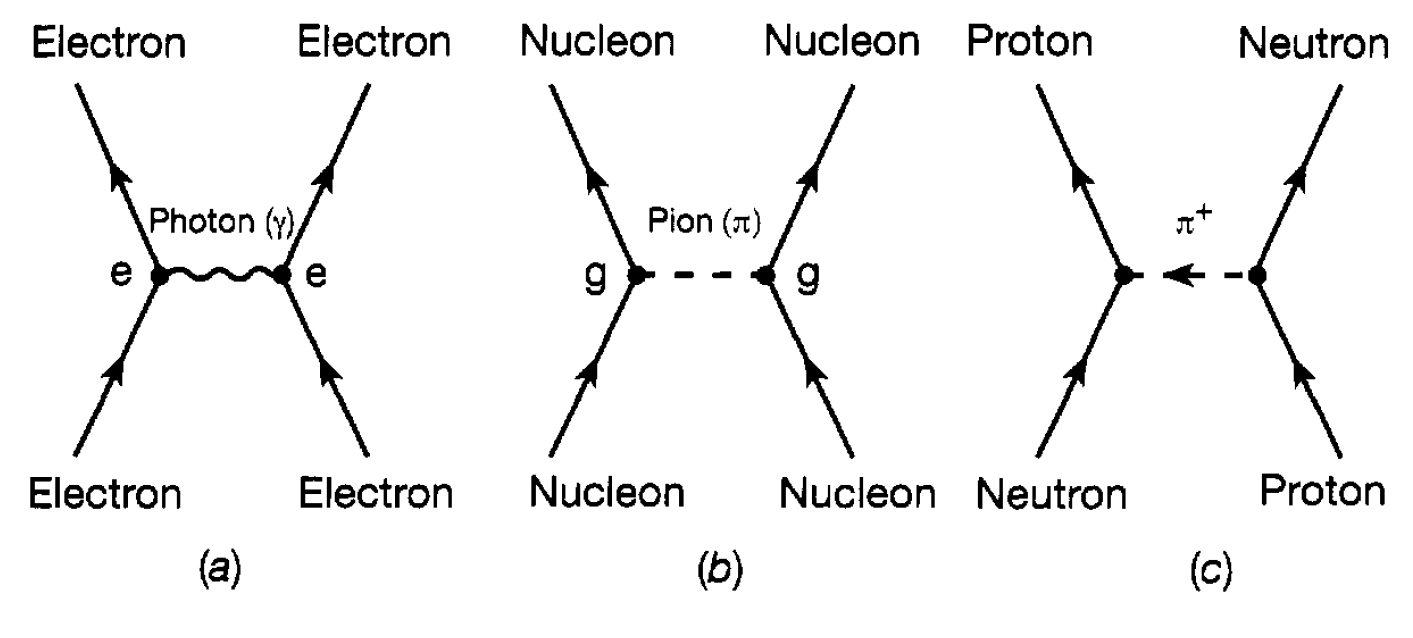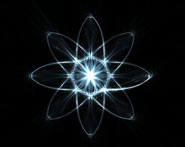


 الفيزياء الكلاسيكية
الفيزياء الكلاسيكية
 الكهربائية والمغناطيسية
الكهربائية والمغناطيسية
 علم البصريات
علم البصريات
 الفيزياء الحديثة
الفيزياء الحديثة
 النظرية النسبية
النظرية النسبية
 الفيزياء النووية
الفيزياء النووية
 فيزياء الحالة الصلبة
فيزياء الحالة الصلبة
 الليزر
الليزر
 علم الفلك
علم الفلك
 المجموعة الشمسية
المجموعة الشمسية
 الطاقة البديلة
الطاقة البديلة
 الفيزياء والعلوم الأخرى
الفيزياء والعلوم الأخرى
 مواضيع عامة في الفيزياء
مواضيع عامة في الفيزياء|
Read More
Date: 1-1-2021
Date: 18-11-2020
Date: 26-3-2017
|
The Nuclear Force
A key feature of the nuclear force emerges by considering the implications of the way in which the binding energy per nucleon (B/A) varies. Imagine starting with one nucleon (say, a proton) and adding additional nucleons to build increasingly larger nuclei. From the curve it is clear that, to begin with, the binding energy per nucleon increases steadily. This can be easily understood because any one nucleon experiences the attraction due to the nuclear force of an increasing number of neighbours as they are added, so it becomes more tightly bound. However, the process does not continue and the B/A curve soon flattens off. Put this another way: for all but very light nuclei the average energy to remove a nucleon is much the same (around 8 MeV) whatever the size of the nucleus. Contrast this with the energy needed to remove a piece of matter from differently sized gravitating bodies-much less energy is needed to launch a rocket from the moon than from the earth. This is because the rocket experiences the gravitational attraction of the whole body; the gravitational force, like the electric force dies away slowly with distance and can be experienced over very large distances it is a long range force. This cannot be so with the nuclear force. It must have a short range so that, in removing a nucleon from a nucleus, energy only has to be provided to overcome the force of attraction due to its immediate neighbours, the number of which is roughly the same for all nuclei except for the lightest. Any one nucleon does not experience the attractive force of more distant nucleons. The range of the nuclear force must, therefore, be less than the size of an average nucleus and can be estimated to be around Here it should be remarked that it is the long ranged nature of the repulsive electric force between protons, so that all the protons in a nucleus experience it, that inhibits the inclusion of too many protons in a nucleus. As nuclei become bigger this repulsion also reduces the binding energy B and leads to the gradual drop in the value of B/A as A, and therefore 2, moves to very high values. Since nuclei increase in size the more nucleons they contain it also follows that, however powerful the nuclear force, nuclei do not collapse under its influence-nucleons keep their distance. The force must therefore have a very short range repulsive element which does not allow the nucleons to approach very closely to each other. The nuclear force must therefore have a general form similar to that of the interatomic potential except that the strength and range are utterly different. The interatomic force has a range measured in atomic sizes (of the order of 10-10m) as against the nuclear force range (10-l5m). The depth of the interatomic potential well is measured in electron volts (eV) whereas the nuclear potential well must inevitably be of the order of the average binding energy per nucleon, namely measured in millions of electron volts (MeV). Very roughly speaking the nuclear force is a million times stronger and a million times shorter ranged than the interatomic force. The fine details of the nuclear force have been exhaustively established by studying the way in which neutrons and protons behave when they are scattered one from the other like billiard balls. This involves accelerating protons by subjecting them to powerful electric fields in an accelerator or using neutrons from nuclear reactions such as that used by Chadwick in the experiment. Information has also been derived from studies of the lightest composite nucleus (the heavy hydrogen nucleus known as the deuteron) consisting simply of a proton and a neutron bound together. Here, for example, it emerges that the spins of the proton and neutron (each has spin ½) in this nucleus are parallel so that the total spin is 1; when their spins are antiparallel the force is not strong enough to hold them together. This is a simple example of the extreme complexity of the nuclear force, which turns out to be highly dependent on the directions in which nucleon spins are pointing not only in relation to each other but also in relation to their directions of motion. One other important feature emerges, namely that the nuclear force between two neutrons, two protons or a neutron and a proton is exactly the same when the two particles are in the same state of motion (quantum state). Of course, since protons have an electric charge, its effects have to be subtracted out first to arrive at this conclusion. The implication is that neutrons and protons are intimately related and can be regarded as two different manifestations or states of the particle which, as has been mentioned, we call the nucleon. Although they have very different electromagnetic properties charge and magnetic behaviour they behave identically as far as the strong nuclear interaction is concerned. This identity in behaviour is reflected in the energy levels of what are called mirror nuclei. These are nuclear pairs such as the oxygen nucleus (eight protons, nine neutrons) and the fluorine nucleus (nine protons, eight neutrons). It is found that their energy levels are essentially the same, any differences being attributable to the electric charges of the protons. Finally, we turn to the origin of the nuclear force. The electric force between, for example, two electrons can be understood in classical terms as due to the electromagnetic field between the electrons. This field, is propagated with the speed of light and, in quantum terms, the transmission of the field is by means of photons. Photons, as we have seen, behave like particles carrying momentum and energy but having zero rest mass. Thus a picture emerges in which the electric force between two electrons is understood in terms of the exchange of photons (symbol y) between them as illustrated in figure 1.1(a) where the photon is represented by a squiggly line. The photon is created by one electron and annihilated by the other. In some ways the interaction between them is rather like that between two tennis players who influence each other’s movements attraction and repulsion by how the ball is exchanged between them. The formal quantum mechanical theory describing such an interaction between charged particles is known as quantum electrodynamics. It is called a gauge theory and the photons, which have spin 1, are also referred to under the collective name gauge bosons.

Figure 1.1: (a) Photon exchange between electrons; (b) pion exchange between nucleons; (c) charged pion exchange between nucleons.
In 1935 a Japanese physicist Hideki Yukawa suggested that the short range nuclear force could be understood in a similar way but with the exchange of a finite-mass particle between nucleons instead of a photon. Just as photons are created and absorbed by charged particles, so this newly proposed particle is created and absorbed by nucleons. Of course, for such a particle to be created by a nucleon, energy E = moc2 would be needed, where m, is the rest mass of the particle. Where does such a large amount of energy come from?. Here it must be remembered that in quantum mechanics there is always a short period during which energy does not need to be conserved-there is an uncertainty about its value. This uncertainty is embodied in the uncertainty. If we trade on this energy uncertainty and equate it to m0c2, then, from the uncertainty relation, it follows that the short time for which this energy is available is of the order h/(m0c2) where h is Planck’s quantum constant. The maximum speed with which the particle can travel is the speed of light, c, and hence the furthest distance it can travel is given by the product (speed × time), namely c × h/(m0c2) = h/( m0c2). If this distance is to be the range of the nuclear force (around 10-15,) then it requires m0 to be a few hundred times the mass of an electron (remember nucleons are around 1840 times the mass of an electron). No such particle was known when this hypothesis was put forward by Yukawa and it was not discovered until 1947 when Powell and his colleagues detected a particle, now known as the pi-meson or pion (denoted by π ) during their studies of cosmic rays, which satisfied all of the requirements. Cosmic rays consist of a variety of particles falling on the earth from outer space which they detected by exposing photographic plates at high altitudes. Particles passing through the plates disturb the photographic emulsion and leave ‘tracks’ whose nature enables the particle mass to be estimated. The mass turned out to be around 270 times the electron mass and so Yukawa’s idea was established. The pion was also found later to have spin 0. In figure 1.1(b) a representation of the pion exchange process is shown where the pion is denoted by the dotted line. Diagrams such as those in figure 8.3 are generally referred to as Feynman diagrams. In the same way that the strength of the electric force is determined by the charge e, so the strength of the nuclear force is denoted by a symbol g which is referred to as a coupling constant since it measures the strength with which the pion is coupled to the nucleon. To account for the strength of the nuclear force g2 needs to be around 100e2 . This means that this interaction is strong compared with the electromagnetic interaction and it is one manifestation of what has already been referred to as the strong interaction. Many more exchanged particles, generally referred to as mesons, are now known to contribute to the nuclear force. Some, including pions, carry electric charges; for example pions exist with no charge (π0),w ith charge +e (π+)n d with charge –e (π-), all three particles having essentially the same mass. As a result a neutron and a proton interacting with each other can exchange their identities by exchanging, for example, a π+. Such a charge exchange process is illustrated in figure 1.1(c) and leads to the frequently observed phenomenon of neutrons and protons ‘changing places’ when scattering one another. In terms of these many different and varied processes, a very full understanding of the complex nature of the nuclear force has now been obtained.



|
|
|
|
اكتشاف تأثير صحي مزدوج لتلوث الهواء على البالغين في منتصف العمر
|
|
|
|
|
|
|
زهور برية شائعة لتر ميم الأعصاب التالفة
|
|
|
|
|
|
موكب أهالي كربلاء يستذكر شهادة الإمام الصادق (عليه السلام)
|
|
|
|
العتبة العباسية تستذكر شهادة الإمام الصادق (عليه السلام) بإقامة مجلس عزاء
|
|
|
|
أهالي كربلاء يحيون ذكرى شهادة الإمام الصادق (عليه السلام) في مدينة الكاظمية
|
|
|
|
شعبة مدارس الكفيل النسوية تعقد اجتماعًا تحضيريًّا لوضع الأسئلة الامتحانية
|